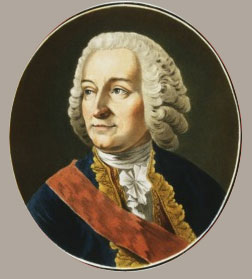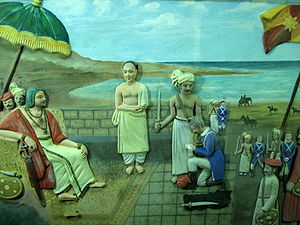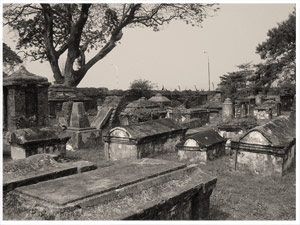Austrian War of Succession.
Marthanda Varma and the Dutch signed the agreement.
De Lenoy reforms the Travancore troops.
Dupleix came as French Governor.

1743
Marthanda Varma and the Dutch Sign Agreements
The Austrian War of Succession is going on in Europe with the English and the French in hostile camps. Despite eating their humble pie at the Battle of Kulachal, the Dutch continued their war in south Kerala. The French, establishing friendly relations with the king of Travancore strengthened their trade. They were in friendly terms with the Nawab of Carnatic with their eyes on the trade centres in Carnatic.

The Marathas, in the meanwhile, surprised the French attacking Arcot, creating troubled waters in the Carnatic politics. During this period, infusing in to the French a new awakening, there emerged Joseph Francois Dupleix as governor general of French possession (1742) giving rise to nervousness in both the camps of the Dutch and the English. With the arrival of valorous and adventurous Dupleix, the trade arena, so far confined in Malabar between the hostile Dutch and the English, began to spread not only in the northern parts of Kerala but also in Carnatic in south India giving rise to stiff competition. Marthanda Varma became a nightmare among the kings of Kerala, who saw in Dutch a formidable opponent of him. Despite their fiasco in the Battle of Kulachal, the Dutch, gathering fresh energy and momentum, came forward trying to help the countries with whom they had trade relations.

Marthanda Varma at the Battle of Kulachal.
Marthanda Varma was pursuing his war and annexations against the neighbouring states procuring additional arms from the French and the English and modernising his troops on European lines. He modernised his troops making use of the services of deserters of Dutch forces and of those surrendered at the Battle of Kulachal. He made effective use of the services of Eustache De Lanoy and Carl August Duijivenschot who were formerly with the Dutch troops. Even before the Battle of Kulachal, Duijivenschot, who was quite loyal to the King, rendered his military services. Historians recorded that De Lannoy was one among those who surrendered before Marthanda Varma at the Battle of Kulachal. But the present version of the historians is that he, quarrelling with the Dutch military and shifting his loyalty came over to the palace of Marthanda Varma with his group prior to the Battle of Kulachal. No doubt, De Lannoy played a prominent role in modernising the troops of Travancore and in erecting fortresses and in creating cannons, big guns and other weapons. The military might under his leadership and the productive power of intelligence on the part of the Dalawa Ramayyan paved the way for later victories of Marthanda Varma over his foes.
After the Battle of Kulachal, the Dutch again made attempts to block the advancement of Marthanda Varma. With the help of Desinganadu, they attacked Vamanapuram though they were constrained to give it back. The Travancore troops later encircled the fort of Quilon when Achutha Warrior, the minister of the king of Kayamkulam, defended it. The seizure of Kilimanoor, by the combined forces of the Dutch and Kayamkulam, became a terrible shock to Marthanda Varma. With the help of cavalry came from Thirunelveli Marthanda Varma started repulsing the attacks and the troops of Travancore reached at Kayamkulam whose king's appeal for peace was accepted by the King. Coming to know the loss of the countries that supplied them pepper, the Dutch tried their level best to sign over a treaty with Travancore at any cost but the king evaded them putting forth lame excuses. The Dutch also made out the fact that Marthanda Varma was desirous of making a treaty direct with Cochin and improving the ties with the French and the English and so they readied to sign an agreement with him in tune with his interests. And thus on 22 May 1743 Marthanda Varma and Reinicus Siersma Commander signed an agreement, the latter acting for and on behalf of the Dutch governor Van Imhoff.
THE WAR OF AUSTRIAN SUCCES
Charles VI, the Emperor of Austria, made the other countries accept the pragmatic sanction he chiselled out ensuring the accession of his daughter Maria Theresia to the throne after his death. But when she became the empress, the King of Prussia (later Germany), Frederic II violated the sanction. Louis XV, the Emperor of France, came in support of Prussia while George II of England sent forces to support Austria. The war at home had greater reflections among the British and French in India then. The victory in the Austrian war was with the France and the war ended in 1748 as per the Treaty of Aixe-la-Chappelle.
As per the treaty, the Company had to be given away 1200 kandi dried pepper (at the rate of Rs 54 per kandi) through the merchants of Quilon and Pandara Thuruthi. The Dutch had to give away to the King guns and balls worth 100 kandy pepper. The Dutch had to be allowed to reconstruct the fort of Kulachal and help Tranvancore with cannons and troops if it was being attacked by the forces of the Nawab of Carnatic. But the right of Marthanda Varma to attack the kingdoms Kayamkulam and Desinganadu was hidden in the treaty. Historians are of the opinion that the clever and cunning king signed the treaty faced with the threat of invasion by the Nawab at his eastern border. He was devising strategies to capture the neighbouring countries after having signed the Treaty. He, step by step, started implementing the strategies.
DE LANOY AND HIS FAMILY REST IN PEACE HERE
The services of Eustachius Benedictus De Lanoy were an important chapter in the history of Travancore. The present version of the historians is that he, prior to the Battle of Kulachal, deserted the Dutch forces and enrolled himself in the troops of Travancore shifting his loyalties. There are dispute among the historians about his place of birth. The great poet and researcher Ulloor S Parameswara Aiyyar in his treatise, the Great Captain mentioned that he was born in Belgium as a Roman Catholic and later joined in the Dutch East India Company. But Mark de Lannoy, a family member of him, in his book the Kulashekhara Perumals of Travancore, struck a discordant note by saying that he was born in Arras, a French city in 1715. His desertion was because of the dispute between the officials of Dutch East India Company.

Marthanda Varma, in the beginning, made out his skill and valour and his proclivity to modernise the troops of Travancore. He had been showered with love and attachment by the king. An expert in the construction of forts, he worked first under the Duijvenschot the German Commander. With his death De Lanoy became the commander and gradually the commander in chief. He became the most important force behind the march of victory of Marthanda Varma by modernising the Travancore troops in toto making modern war equipments for it. Travancore started making cannons and guns which even the European forces were not in possession of. At important places he established military barracks and gun powder store houses. Udayagiri was transformed in to the important centre of armed forces. Construction of forts and renovation of the existing forts were another area of modernisation practised by him. For all these measures he had the support of the Dalawa Ramayyan.
His residence was in Udayagiri Fort. He married Margaret, the daughter of an interpreter at the fort of Anjengo. She was a Syrian Christian. Her father opposed their marriage. But because of the intervention of Marthanda Varma, the marriage took place. Their son, Joannes, who also served the armed forces of Travancore, died later in the war field. The death of his son weakened De Lanoy who was given permission to construct a church in the fort of Udayagiri in memory of his son by Karthika Thirunal (Dharma Raja). De Lanoy bid good bye to the world on 1st June 1774. At the fort of Udayagiri (now in Cape Comerin, Tamilnadu) one can find tombs of De Lanoy and his family.